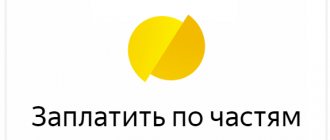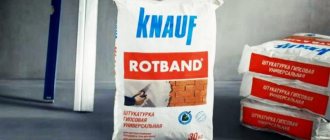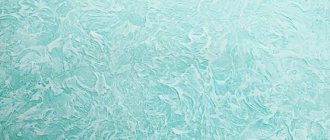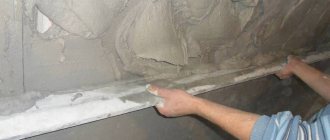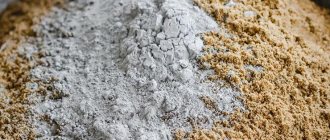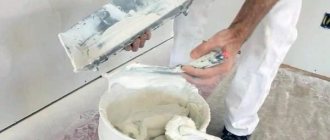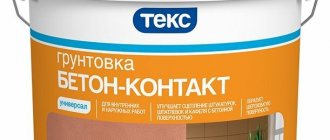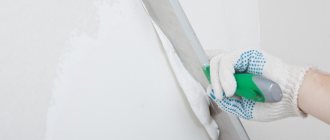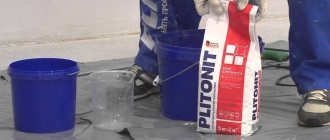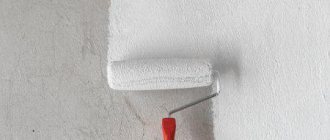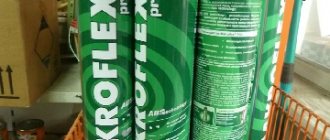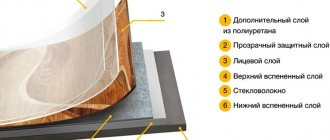External and internal finishing of a building is an indispensable attribute of construction and repair work, thanks to which the premises become suitable for use, and the building as a whole receives an aesthetic appearance and protection from the adverse effects of external environmental agents.
The quality of finishing often depends not so much on the finishing material itself, but also on the degree of preparation and quality of the surface to be finished.
Dry plasters from the manufacturing company “Volma” are today one of the best mixtures in their market segment.
Volma Layer (New):
— gypsum is used as a binder;
— applied to the internal surfaces of premises for their further finishing;
— any cement-sand, gypsum, clay surfaces are used as bases;
— does not require subsequent priming and puttying;
- gives a shiny surface;
— bending strength from 1.0 MPa.
Advantages of gypsum plaster.
One of the main advantages is its versatility.
Gypsum-based mixtures produced by Volma “Plast” and “Canvas” can also be used for decorative purposes.
The use of these mixtures allows you to achieve the most ideal result; the surface is not just smooth, not requiring further putty, but also glossy, smooth and even.
Gypsum-based mixtures set fairly quickly, which is a significant time saver. The effect of rapid drying is achieved by adding special components (chemical and mineral origin) to the composition, which in turn guarantees high strength, as well as very good adhesion.
All mixtures are presented in several color options. As a rule, these are neutral pastel shades - gray, white. If further decorative finishing is envisaged, you can choose mixtures of rare shades - pink, green, yellow.
Advice: the optimal layer thickness is 0.2-0.6 cm. If a thicker layer is breaded, then it is necessary to apply the plaster in several stages. The next layer should be applied only after the previous one has completely dried.
Volma-Layer Ultra (New):
— gypsum is used as a binder;
— applied to the internal surfaces of premises for their further finishing;
— any cement-sand, gypsum, clay surfaces are used as bases;
- resistant to cracking;
- gives a shiny surface;
— bending strength from 1.5 MPa.
Prices and material consumption
Now let's talk about prices and consumption of plaster mixtures. It all depends on the chosen model.
Volma-Layer Universal
For a plane with an area and thickness of 1 m2 and 1 mm, 0.85 kg will be required. One bag (30 kg) costs 354 rubles.
Volma-Canvas Gray
For a plane with an area and thickness of 1 m2 and 1 mm, 1 kg will be required. One bag (30 kg) costs 308 rubles.
Volma Stroiver Mechanic
For a plane with an area and thickness of 1 m2 and 1 mm, 1 kg will be required. One bag (30 kg) costs 221 rubles.
Volma My House
For a plane with an area and thickness of 1 m2 and 1 mm, 1 kg will be required. One bag (25 kg) costs 263 rubles.
Volma Layer Light
A plane with an area and thickness of 1 m2 and 1 mm will require 8 kg. Two 5 kg bags cost 230 rubles.
Volma-Akvaplast
For a plane with an area and thickness of 1 m2 and 1 mm, 1.6 kg will be required. One bag (25 kg) costs 247 rubles.
Volma-Aquaslayer
For a plane with an area and thickness of 1 m2 and 1 mm, 1 kg will be required. One bag (25 kg) costs 245 rubles.
Volma Gips Active
For a plane with an area and thickness of 1 m2 and 1 mm, 1 kg will be required. One bag (30 kg) costs 260 rubles.
Volma-Plast
A plane with an area and thickness of 1 m2 and 1 mm will require 9 kg. One bag (30 kg) costs 248 rubles.
When buying dry products, you need to take a little more than is required for the job. This is done so that during the process more mixtures can be diluted if necessary. It is better to have a surplus than not to finish what you started.
Volma-Canvas
— gypsum is used as a binder;
— applied to the internal surfaces of premises for their further finishing;
— any cement-sand, gypsum, clay surfaces are used as bases;
- applied manually;
- forms a shiny surface;
— bending strength from 1.5 MPa.
Volma-Aqualux
— cement (based on quartz sand and Portland cement);
— for interior and exterior finishing works;
— applied to bases made of lightweight concrete, brick, cement plasters under facing with stone or tiles;
— manual and machine application methods are possible;
- applied in a thin layer;
- resistant to cracking;
- reinforced.
Bases and surfaces on which Volma plaster can be applied
This plaster can be applied to various construction substrates:
- plasterboard and gypsum fiber sheets;
- brick;
- concrete;
- gas and foam concrete;
- gypsum blocks;
- chipboard;
- cement-lime plasters.
Technical specifications
- Drying time for plaster is up to 7 days;
- initial setting period – after 40 minutes;
- the final setting period is no later than 3 hours;
- The recommended layer height is up to 30 mm. Layers applied greater than this parameter are applied in two stages;
- maximum thickness of the plaster layer – 60mm;
- liquid consumption for the solution is 0.6 – 0.65 liters of water per 1 kg of mixture;
- plaster "VOLMA" mixture consumption per 1 m2 with a layer thickness of 1 mm - 1 kg;
“VOLMA” plaster, the price per layer of one application, which will be slightly more expensive than other domestic plasters, but this is compensated by the quality of the material, which is not inferior to Rotband, but much cheaper.
Preparing the base for plastering work
Before plastering, the base of the wall or ceiling should be very thoroughly cleaned of various layers, dust, oil stains, dirt and then dried. Detached areas must be strengthened, potholes must be repaired. If there are large irregularities, fungi and white salt deposits, they must be eliminated.
The result should be a smooth, rough surface and a stable, evenly absorbent, strong base. Protruding metal parts must be treated with an anti-corrosion compound. The surface to be plastered must not be frozen. The minimum base temperature for plastering work is +5 C0, the maximum humidity level is 5%.
Before applying “VOLMA - Layer” plaster, the base must be coated with a primer that matches the type of base. Based on the rate of moisture absorption, bases are divided into strongly, normally and weakly absorbent. It is recommended to apply VOLMA-Kontakt primer on weakly absorbent substrates, and VOLMA-Universal or VOLMA-Plast primer on highly absorbent substrates.
A guide corner profile is installed on the protruding outer corners of the wall or ceiling. It is fixed to the base using mounting adhesive or gypsum plaster. In this case, the solution is applied to the inside of the guides and to the surface of the corner of the base. The corner profile should be pressed against the wall first in the center, and then gradually transfer the pressure to the edges.
Technological process of working with “Volma – Layer” plasters
The required volume of water at room temperature is poured into a clean plastic container at the rate of 1 kg of mixture per 0.6 liters of liquid, and the gypsum mixture is poured. The solution is thoroughly mixed with a construction mixer until smooth and allowed to settle for several minutes.
The process of preparing gypsum plaster using a drill with a special “mixer” attachment.
After 20 minutes, the freshly obtained solution is applied to the prepared surface in a layer of 5-60 mm using a trowel. The applied mixture is leveled using the rule. After the initial coat has completely dried, a second coat can be applied if necessary. After 40-60 minutes after setting and drying, the surface is trimmed using the rule.
Twenty minutes after trimming, the resulting surface is sufficiently moistened with water using a sponge material and smoothed with a wide spatula. The result is a perfectly smooth surface, which is quite suitable for wallpapering. To prepare the surface for touch-up painting, after another 3 hours it is necessary to soak it generously with water and smooth it with a spatula. To decorate a wall with a pattern or texture, various painting and plastering tools are used: rollers, brushes, spatulas, trowels, sponge trowels. With their help, the surface, after leveling, is finished with a decorative pattern.
The drying period on the walls and ceiling is determined by the thickness of the plaster layer, humidity and temperature in the room and is approximately seven days. Supply ventilation will speed up this process.
Volma-Akvaplast
— cement (based on Portland cement);
— for interior and exterior finishing of any building elements for further tiling;
— applied to bases made of concrete (including lightweight) and brick;
— can be used in damp rooms;
- applied manually;
— basic;
- resistant to cracking;
- reinforced;
— bending strength from 2.5 MPa.
Volma-Aquaslayer-MN
— cement (based on Portland cement);
— applied to the internal surfaces of premises for their further finishing;
— any cement-sand, gypsum, clay surfaces are used as bases;
- applied by machine;
— can be used in damp rooms;
- resistant to fungal infection;
— bending strength from 1.0 MPa.
Narrow profile compounds
It is customary to consider decorative plaster separately. But here the choice should also be based on the characteristics of the rough surface. Almost any waterproof mixture is suitable for the facade (only acrylic plaster has limitations due to its low vapor permeability). And for interior work, with a well-prepared foundation, you can completely limit yourself to selecting the desired decorative effect.
Sometimes non-standard requirements are imposed on the leveling mixture, dictated by the characteristics of a particular room. To finish such unusual objects, special compositions are produced:
- Warm - with thermal insulating granules of foam glass or expanded polystyrene, expanded volcanic perlite.
- Acoustic - obtained by adding sound absorbers (expanded clay, vermiculite, pumice). To prevent noise insulation properties from being reduced, they are not coated with regular paint.
- Special - X-ray protective (barite mixtures) and acid-resistant silicate compounds.
The best manufacturers
Having decided on the appropriate type of plaster, you can proceed to choosing a brand. On the Russian market, according to consumer reviews, several companies offer mixtures of the highest quality.
1. Knauf.
Gypsum Rotband with excellent properties is produced using German technology in several regions of Russia. This is one of the most expensive brands (from 360 rubles per bag), although it is also the most convenient to use. Knauf Rotband is a very plastic mass that even inexperienced plasterers can safely use.
Unfortunately, Rotband in the Russian version has lost one important quality - stability of characteristics. Each of the four factories operating in the country uses raw materials from its “own” quarry, so dry mixtures differ in shade, viscosity and size class
2. Prospectors.
A fairly large assortment of dry mixtures at an average price of 280 rubles is offered by the domestic brand Starateli. Interior gypsum and cement plaster for the facade of this company has a lower specific gravity due to lighter aggregates. However, this decision by the manufacturers led to the fact that the gypsum finish became somewhat softer than its analogues, although not by much.
Compared to Rotband, the yield of the finished solution after adding water from Starateley is up to 25% higher, which reduces the cost of purchasing material for the same application thickness.
3. Unis.
Like most domestic compounds, it stands out for its quite affordable price. The gypsum Teplon White, which costs about 280 rubles, has earned good reviews from craftsmen due to its economical consumption and elasticity.
At the same time, Teplon allows application in a very thick layer - up to 70 mm, while the rest of the participants in our review are limited to a thickness of 50-60 mm. So for particularly uneven surfaces with large differences in height, this plaster is ideally suited.
4. Volma.
Economy option of good quality from 250 rubles per bag. Despite the predominance of gypsum compositions in the manufacturer’s assortment, Volma focuses on the production of waterproof mixtures. If you need plaster to level walls in damp rooms, then look for it here.
Volma-Sloy is distinguished by its pure white color, minimal shrinkage and very fine grinding, which allows it to be used simultaneously as a finishing coating for painting. Only Chelyabinsk-made products add a fly in the ointment - their quality is slightly lower, and there is a high risk of cracks.
Buying Tips
When purchasing dry plaster mixtures, you need to ensure that the packaging is intact and without signs of wetness. For ready-made solutions not intended for work on facades, storage conditions that do not allow freezing are important. True, it will not be possible to verify this; we can only hope for the integrity of the seller.
Choosing products from famous brands is, in principle, the right decision. But here you should be especially careful, since it is the expensive mixtures that are most often copied in underground workshops
All well-known brands must have distinctive anti-counterfeit signs on their packaging - pay attention to this
Volma-Cement-Active
— cement (based on Portland cement);
— applied to the internal surfaces of premises for their further finishing;
— any cement-sand, gypsum, clay surfaces are used as bases;
- applied by machine;
— can be used in damp rooms;
- resistant to cracking;
- resistant to fungal infection;
— bending strength from 1.0 MPa.
